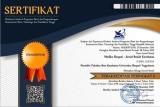Hubungan Nyeri Persalinan Sectio Caesarea Terhadap Terjadinya Depresi Postpartum Pada Ibu Primipara di RSUD Kota Yogyakarta
Abstract
Background: Depression is very common in women, especially on reproductive age. It is estimated that 14% -23% of pregnant women experience depression during pregnancy, and 5% -25% experience postpartum depression. Mothers with caesarean sectio labor experience high scale pain during the first 24 hours. Objective : this study aims to analyze the relationship between caesarean section labor and postpartum depression in primiparous mothers. Methods: The research method used is descriptive analytic with cross-sectional approach. The sample in this study were 20 postpartum caesarean mothers in Yogyakarta City Hospital taken by purposive sampling. Data collection tools in this study are using the Numeric Category Scale (NCS) questionnaire to measure the level of neyri and the Edinburgh Postnatal Depression Scale (EPDS) to measure the level of depression of respondents. Analysis using the Chi-Square correlation test. Results: Most of the level of pain in postpartum SC mothers is in the moderate category that is there are 9 people or (45.0%). Most postpartum mothers in the moderate depression category were 9 people or (45.0%). Statistical results with the Chi Square test showed that there was a significant relationship between labor pain in caesarean section and postpartum depression in primiparous mothers with (p-value = 0.002) (p <0.05). Conclusion: There is a relationship between labor pain in caesarean section and postpartum depression in primiparous mother.
Keywords
Full Text:
PDFReferences
ACOG (2017). Early Pregnancy Loss. The American College of Obstetricans and Gynecologists (ACOG). Practice Buletin No 150, Reaffirmed 2017.
Ajartha, Ronny (2007). Efek Pemberian Tramadol Intramuskular terhadapNyeri Persalinan pada Primigravida. Tesis. Sumatra : FK-USU
American Medical Association (2013). American Medical Association Compelete Guide to Prevention and Wellness. Wiley, United State of America.
Bobak, L. J (2005). Keperawatan Maternitas. Jakarta : EGC.
Depkes RI (2010). Laporan Pencapaian Tujuan Pembangunan Milenium di Indonesia. Jakarta : BAPPENAS
Diniyah, Kharisah (2014). Gambaran Depresi Postpartum di RSKIA Sadewa Yogyakarta. Jurnal Media Ilmu Kesehatan Vol. 6. No. 2 Agustus 2017.
Fitri, Milla (2012). Hubungan Intensitas Nyeri Luka Sectio Caesarea dengan Kualitas Tidur Pada Pasien Postpartum Hari Ke-2 di Ruang Rawat Inap RSUD Sumedang. Students e-Journals. Vol 1, No 1.
Gerbershagen, H. J., Rothaug, J., Kalkman, C. J., & Meissner, W (2011). Determination of Moderate to Severe Postoperative Pain on the Numeric Rating Scal: a Cut off Point Analysis Applying Four Different Methodes. British Journal of Anaesthesia.
Hutagaol, E.T (2010). Efektivitas Intervensi Edukasi pada Depresi Postpartum. Tesis
If World Health Organization (2015). Trends in Maternal Mortality: 1990 to 2015. Geneva: WHO, UNICEF. UNFPA, and The World Bank
Judha, M (2012) Teori Pengukuran Nyeri Persalinan. Yogyakarta: Nuha Medika.
Kalstrom, Olofsson, Morbergh, Sjoling, Hildingson (2007). Postoperative Pain After Caesarean Birth Affect Breast Feeding and Infant Care. Retrived from: https://www.ncbi.nlm.nih.gov/pubmed/17880313. Pada tanggal 02 Oktober 2019.
Kaya L, Çiğdem Z. (2019). The relationship between mode of delivery and postpartum depression. J Educ Health Promot. 2019;8:5. Retrived from doi: 10.4103/jehp.jehp_97_18.
Kementrian Kesehatan RI (2013). Riset Kesehatan Dasar 2013. Diakses tanggah 27 Juni 2017 Retrived from: http://depkes.go.id/downloads/riskesdas2013/hasil%20Riskesdas%202013.
Kemenkes (2011). Data Pendidik Sasaran Program Pembangunan Kesehatan 2011-2014. Jakarta
Kuo, S., Chen, S., & Tzeng, Y (2014). Depression and anxiety trajectories among women who undergo anelective cesarean section. Journal Plos One, 9 (1), e86653. Retrived
Nurhayati, N A (2015) Relaksasi Autogenik Terhadap Penurunan Skala Nyeri Pada Ibu Post Operasi Sectio Caesarea. Jurnal Skolastik Keperawatan. Vol 1, No. 2 Juli–Desember 2015 hal 53–60.
Linton & Shaw (2011). Impact of Psychological Factors in the Experience of Pain. Retrived from: https://academic.oup.com/ptj diakses pada tanggal 29 September 2019.
Manuaba, Ayu Ida C.H. Nagus, Ida D.F. Manuaba Ida Bagus (2008). Ilmu Kebidanan, Penyakit Kandungan, dan KB. Jakarta: ECG.
Munawaroh,H. 2008. Hubungan Paritas Dengan Kemampuan Mekanisme Koping Dalam Menghadapi Postpartum Blues Pada Ibu Post Sectio Caesaria Di Bangsal Mawar 1 RSUD Dr. Moewardi Surakarta. Skripsi (Tidak Diterbitkan). Surakarta: Fakultas Ilmu Kesehatan UMS.
Palupi, F. H. (2013). Perbedaan Tingkat Kecemasan Ibu Primigravida dengan Multigravida dalam Menghadapi Proses Persalinan Kala I di Rumah Sakit Bersalin Ngudi Saras Jaten Karanganyer. Jurnal Maternal. Volume 8 Hal 56.
Riset Kesehatan Dasar (RISKESDAS) (2010). Badan Penelitian dan Pengembangan Kesehatan Kementrian Kesehatan RI. Jakarta.
Sariyem (2013). Ketepatan Waktu Pelayanan Sectio Caesarea dan Lama Rawat Inap di RSU Santa Maria Pemalang. Thesis. Diakses pada tanggal 22 September 2015.
Soep (2011). Penerapan Edinburgh Post-Partum Depression Scale secagai Alat Deteksi Risiko Depresi Nifas Primipara dan Multipara. Jurnal Keperawatan Indonesia, Vol 14 No. 2 Hal 95-100
Sousa, Pitangui, Gomez, Nakano, Ferreira (2009). Measurement and Characteristics of Post Cesarean Section Pain and the Relationshio to Limitation of PhysicalActivities. Retrived from: http://www.scielo.br/pdf/ape/v22n6/en_a03v22n6.pdf diakses pada 01 Oktober 2019.
Smeltzer, S. C, & Bare, B. G (2010). Buku Ajar Keperawatan Medikal Bedah. Jakarta : EGC
Smith, Sullivan, Chen, Burnett & Briggs (2014). Low Back Pain Beliefs Are Associated to Age, Location of Work Education and Pain Releated Disability In Chinese Healthcare Professionals Working In China: A Cross sectional Survey. Retrived from: https://www.ncbi.nlm.nih.gov/pmc/articles/PMC4118206/ diakses 02 Oktober 2019.
Wahyuni, S (2014). Faktor Internal dan Eksternal yang Mempengaruhi Depresi Postpartum. Jurnal Terpadu Ilmu Kesehatan, Volume 3, No 2 November 2014, hlm 106-214.
World Health Organization (2017). Mental disorders fact sheets. World Health Organization. Diakses Januari 2018 Retrived from https://www.who.int/mediacentre/factsheets/fs396/en/-
WHO (2010). The World Health Report 2010. Retrived from http://www.who.int/whr/2010/en/index.html. Diakses pada tanggal 18 Desember 2012.
Wiknjosastro, H (2008). Ilmu Bedah Kebidanan. Jakarta : Yayasan Bina Pustaka.
Yusdiana, Dina (2011). Perbedaan Kejadian Stres Pasca Trauma Pada Ibu Postpartum dengan Seksio Sesaria Emergenci, Partus Pervagina dengan Vakum, dan Partus Spontan. Jurnal Keperawatan Indonesia, Volume 14, No. 3, November 2011; hal 207-212.
DOI: https://doi.org/10.35842/mr.v15i1.266
Article Metrics
Abstract view : 960 ViewPDF - 160 View
Refbacks
- There are currently no refbacks.
Copyright (c) 2020 chici riansih
Medika Respati : Jurnal Ilmiah Kesehatan indexed by:








